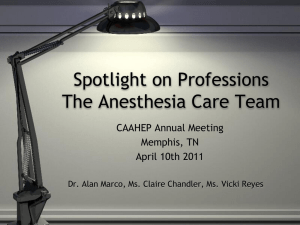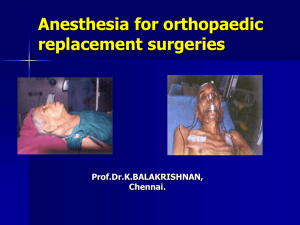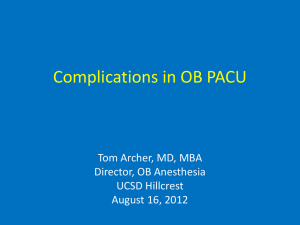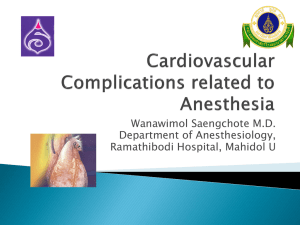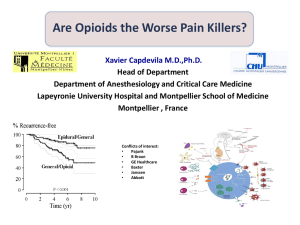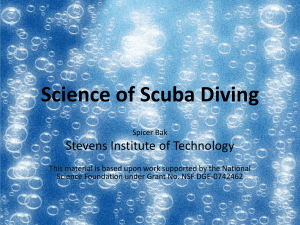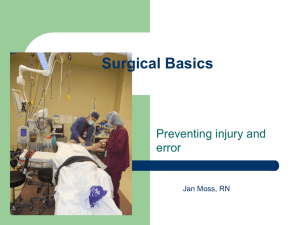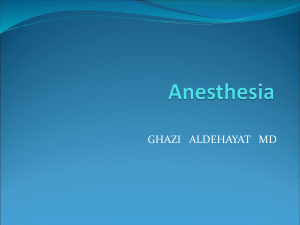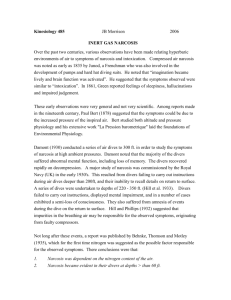anesthesia
advertisement
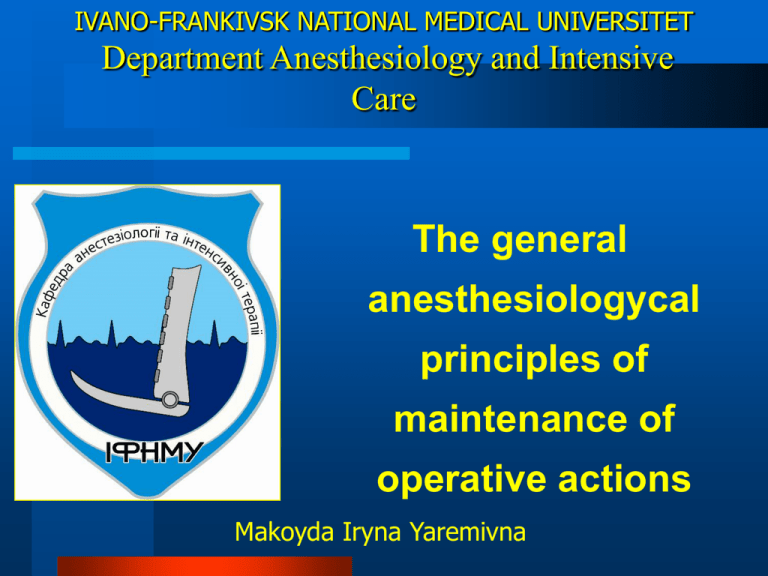
IVANO-FRANKIVSK NATIONAL MEDICAL UNIVERSITET Department Anesthesiology and Intensive Care The general anesthesiologycal principles of maintenance of operative actions Makoyda Iryna Yaremivna The main questions of lecture History of Anesthesia; Anesthesia. Local anesthesia; General anesthesia.; Clinical pictures of narcosis; Devices for narcosis ; The general principles of theoretical and practical anesthesiology The word is derived from the Greek words an, which means “without” and aithesia which means “feeling” The development of anesthesia has made today’s modern surgical techniques possible In modern representation the ANESTHESIOLOGY is an independent section of medicine which develops questions of the theory and practice of anaesthesia and protection of an organism from excessive irritates, which arise during operation. In other words, it is system of protection of a human body from an operational trauma. It expects a number of actions which begin before operation exist during it and come to an end in the period after operation. History of Anesthesia •1772-Joseph Priestly - discovery of N2O •1846-Dr. William T.G. Morton First anesthesia specialist Oct. 16, 1846 - Ether Day at Harvard Medical School •Oliver Wendell Holmes suggested the name "Anesthesia" •Ether synthesized in 1540 by Cordus •Ether used as anesthetic in 1842 by Dr. Crawford W. Long •Ether publicized as anesthetic in 1846 by Dr. William Morton 1847 - M.I.Pirogov - endotracheal narcosis and spinal anaesthesia in experiment, rectal and i/v a narcosis in clinic 1847 y. - Simpson - the first chloroformic narcosis 1847 y. - John Snow - the first professional anaesthesiologist 1863 y. - Green - morfin for premedication 1868 y. - Endrys - narcosis N2O in a combination with О2 •Endotracheal tube discovered in 1878 •Local anesthesia with cocaine in 1885 •1911. Legman - chlorethyleni narcosis •1922 y.- local infiltration anaesthesia by a method creeping infiltrat •1932 y. - i/v gexenaly narcosis •1934 y. - cyklopropanall narcosis •1936 y. - Landi - i/v thiopentaly narcosis •1937 y. - Gvedell - classification of stages of a narcosis •Curare first used in 1942 - opened the “Age of Anesthesia” Influence of operation on an organism Local changes: 1. Occurrence of the painful irritations Common changes: 1. Paine 2. Nekrobiotic damage 2. Neurovegetative and neuroendocrine disorders 3. Allocation of the local vasoactive substances, hormones. 3. Exchanges disorders 4. Development of a local hypostasis 5. Creation of conditions for infection 6. Specific influence on breath bodies (a thorax wound), blood circulations (wounds with a bleeding). 4. Breathing disorder 5. Changes of blood circulation 6. Changes of reological properties of the blood. PAINE This complex sharply negative emotional sensation which arises owing to action of hurting factors on special receptors Stages of formation of painful reaction: 1. Transformation of pathological influence into electric signal in painful receptors, education of a painful impulse 2. Transfer of the created painful signal by afferent nervous ways 3. Formations of sensation of a pain and respective mental reaction, "decoding", "judgement" of a pain in the painful centres 4. Formation of reaction-answer and its transfer on efferent nervous ways INFLUENCE OF PAINFUL IMPULSES ON THE ORGANISM PAINE EXCITATION OF THE VEGETATIVE CENTERS OF THE SUBCORTEX • Stimulation of the sympathetic and parasympathetic nervous systems 2. Hyperproduction of adrenaline, noradrenaline 3. Hyperproduction stressful hormons (ТТH, аldosteroni, cytokines, glukagoni) DEVELOPMENT OF SELIE ADAPTABLE SYNDROME Сardio-vascular system: 1. Таchicardia 2. Increasing of the BP 3. Spasm of arterioles 4. Microcirculation infringement 5. A blood condensation 6. Deterioration reological qualities of blood 7. Hypercoagulation Breathing: 1.Tachypnoe 2. Spasm of bronchioles 3. Decrease of V V of L 4. Increase of breathing hypoxia Metabolism: 1. Hyperglykemia 2. Stimulation of neoglukogenesis 3. Braking of the aerobic glikolisis 4. Disintegration of albumins 5. Increase of acidities and development of the metabolic acidosis Kidneys: 1. Decrease of diuresis 2. Detention of Na+ 3. Detention of Н2О 4. Accumulation of the nitrogenous slags Secondary infringements of functions of all bodies and systems With development of poliorganic insufficiency THE MAIN REQUIREMENTS TO ANESTHESIA METHODS Common (nonspecific) Components of anesthesia 1. Аmnesia – disagreement of consciousness Than it is provided Common anesthetics, sedative drugs, hypnosis 2. Аnalgesium (an-disagreement, algos - Common and local anesthetics, narcotic and no narcotic analgesics a pain) - deenergizings of painful sensitivity Common anesthetic, central and peripheral cholino3. Neurovegetative blockade and аdrenomimetic, neuroleptic 4. Миоплегия - relaxations of muscles Common and local anesthetics. 5. Adequate haemodynamics Drugs for regulation of the rhythm and power of heart contraction, microcirculation, coagulation and reological properties of the blood. 6. Adequate gas exchange Passableness of respiratory ways, blood oxygenation, auxiliary and V of L Correction of metabolism, temperature. Classification of methods of anaesthesia Local anesthesia General anesthesia Types of local anesthsia 1. THE SUPERFICIAL (Terminal): a) Greasing b) Splashes c) Cooling 2. Infiltration : a) The opened b) The closed 3. Explorer (The regional): а) topical b) plexus blocks (novocaini blocks) c) caudal d) epidural i) spinal Local narcosis: •Terminal. •Infiltration. •Regional: juxtaspinal; intercostal; sacral; anaesthesia of jaw area. •Spinal (subarachnoidal). •Epidural. •Intracostal. •Intravenous regional. Anaesthesia of cross-sectional. COMMON (NARCOSIS) 1. The inhalation a) mask b) endotracheal 2. NONINHALATION: а) i\v б) i\m в) peroral г) perrectum д) intracavital - Superficial (terminal) anaesthesia Switches on the prevention of occurrence of painful impulses in the nervous receptors placed in a skin or mucous membranes It is executed by methods: - Greasings (2-5 % a solution of novocaini, lidocaine, paste “Еmla” with prilocaini that lidocaini) - Irrigation (2-5 % solution of novocaini, lidocaine, 10 % an aerosol lidocaini) - Cooling (solution of chlorethyl) EMLA INFILTRATIONAL ANESTHESIA - Expects the prevention of painful impulses in nervous receptors in all fabrics on any depth: 0,25-0,5 % solution of novocaini, lidocaine, marcaini or naropini are spent by such methods: - Closed - all fabrics which will be hurt during operation, stage by stage spend infiltration by anesthetic through pierce in a skin, since “a lemon crust” - Opened – infiltration of fabrics by solution of anesthetic spend gradually, connecting it with cuts CONDACTIONAL LOCAL ANESTHESIA Trunk anesthesia – Interrupts nervous impulses at level of trunk of peripheral nerves 1-2% solution of novocaini or lidocaini enter peri - or endoneural of nervous trunks which perform nervous support an operation zone Anesthesia by OberstLukashevich Block of n.femoralis CONDACTIONAL LOCAL ANESTHESIA Plexus anesthesia (Novocain blocks) – Interrupts nervous impulses at level of nerves plexus, into which projection enter 0,25-0,5% solution of novocaini or lidocaini Vago-sympathy block Paranefral block CONDACTIONAL LOCAL ANESTHESIA Paravertebral anesthesia – Interrupts pain impulses at level of spinal nervs (by arrows it is specified, where enter a solution 1% novocaini, lidocaini, marcaini or naropini) CONDACTIONAL LOCAL ANESTHESIA Peri-(epi-) dural anesthesia – Interrupts pain impulses in peridural space on level of posterior (sensitive) radicals of spinal cord CONDACTIONAL LOCAL ANESTHESIA Sacral (caudal) anesthesia – variant of epidural, when anesthetic entered in epidural space throw canalis sacralis Drugs for epidural anesthesia 1. 2-2,5% sol. Trimecaini 2. 2. 2% sol. lidocaini 3. 0,5% sol. karbostesini (bupivacaini) 4. 2% sol. mepivacaini 5. 1% sol. ropivacaini 6.To them it is possible to add: morphine in doses = 1/10 usual CONDACTIONAL LOCAL ANESTHESIA SPINAL ANESTHESIA Interrupts pain impulses at level of subdural placed posterior radicals and conductive ways of painful sensitivity of spinal cord (tractus spino-thalamicus) Drugs for anesthesia 1. 1,5 – 2 ml 5% sol. novocaini 2. 4 – 5 ml 2% or 2 ml 5% sol. lidocaini 3. 0,5 – 1 ml 1% sol. sovcaini 4. 3 ml 0,5% sol. bupivacaini 5. 3-5 ml sol. ropivacaini GENERAL ANESTHESIA = NARCOSIS Narcosis - is artificial called, potentially reversible status of an organism to which it is characteristic loss of consciousness and oppression of reflex activity; At a deep narcosis the relaxation of muscles, neuro-vegetative blockade, oppression of the vital functions of an organism is observed. Theory of narcosis 1. Coagulative theory of Claude Bernar (1875). 2. Lipoid theory of Meyer and Overton (1899 1901). 3. Theory of "asphyxiation of nervous cages of Fervorn" (1912). 4. An adsorption theory (frontier tension) is offered Traube (1904 - 1913) and Varburg (1914 1918) is supported. Theory of aquatic microcrystal of Polling (1961). Narcosis stages Preparatory stage Anaesthesia induction (introduction narcosis) Stage of maintenance of anaesthesia Stage of exit from narcosis Narcosis stages 1. Preparatory stage The remote preparation: 1. To define an accompanying pathology 2. To liquidate it or to translate in a status of proof remission 3. To define degree operational -anesthesiological risk 4. To spend choice of method of anesthesias 5. To spend psychological preventive job with patients (or his relatives) The direct reparation: 1. Sanitary processing of the patient 2. Preparation o GIT 3. Maintenance of the mental balance and a quiet dream 4. Premedication: analgesics Tranquilisator antiallergic M-holinolitics Narcosis stages 2. Introduction narcosis (inhalator or noninhalator drags) 3. MAINE NARCOSIS spending in ІІІ1-ІІІ3 stages inhalator or noninhalator drags or their combination, narcotic or nonnarcotic analgetics, neuroleptic, hypnotics, sedatives, stimulators of alfa-2-receptors, miorelaxants 4. Exit from a narcosis or awakening 5. Early after narcosis period – Lasts throughout 1 days after operation, demands supervision over the patient by the anaesthesiologist for the purpose of correction of vital signs and homeostasis indicators Narcosis stages І – analgesic; ІІ – Excitation; ІІІ - a surgical stage (ІІІ 1 - ІІІ 4); IV - awakenings (toxic/agonal) Stage of analgesia (I). A patient is in consciousness, but put on the brakes, dozes, on questions answers monosyllabically. A superficial algesthesia absents, but a haptic and thermal sensitiveness is stored. Implementation of brief interferences (dissection of phlegmons, abscesses, diagnostic researches) is possible in this period. Stage brief, 3-4 lasts min Stage of excitation (II). There is braking of centers of bark of large brain in this stage, while under bark centers are in a state of excitation: consciousness absents, motive and vocal excitation is expressed. Patients yell, try to get up from an operating table. The cutaneous covering is bloodshot, pulse frequent, an arteriotony is enhanceable. Pupil wide, but reacts on light, a lacrimation is marked. A cough, strengthening of bronchial secretion, appear often, vomiting is possible. Surgical manipulations on a background excitation, conducting is impossible. In this period it is necessary to continue the satiation of organism a narcotic mean for deepening of anesthesia. Duration of the stage depends on the state painof ного, experience of anaesthetist. Excitation usually lasts 7-15 min Surgical stage (III). With the offensive of this stage of anesthesia of patient calms down, breathing becomes even, a heart rate and arteriotony approach an initial level. Realization of operative interventions is possible in this period. Leadingout from anesthesia Awakening stage, begins from the moment of stopping of serve of anesthetic. The concentration of anesthetic diminishes in blood, a patient passes upside-down, all stages of anesthesia and awakening comes. Monitoring of depth of narcosis Monitoring of depth of narcosis Preparation of patient to anesthesia. A patient is examined before an operation, here not only pay attention to basic disease which an operation coming concerning but also in detail find out the presence of concomitant diseases. If a patient is operated in the plan order. that if necessary is conducted treatment of concomitant diseases, sanation of cavity of mouth. A doctor finds out and estimates the mental condition of patient, allergist anamnesis finds out, specifies, whether a patient carried in the past operations and anesthesias. Pays attention to form of person, thorax, structure of neck, expressed of fatty hypoderm. All of it is necessary, that it is correct to choose the method of anaesthetizing and narcotic preparation. The important rule of preparation of patient to anesthesia is clearing of gastrointestinal tract (washing of stomach, cleansing enemas). Premedication An aim of premedication is a removal of psychical tension, sedative effect, warning of undesirable neurovegetative reactions, diminishing of sialosis, to the bronchial secretion, and also strengthening of anesthetic and analgetic properties of narcotic matters. It is arrived at by application of complex of pharmacological preparations. In particular, for the psychical calming tranquilizers, barbiturates, neuroleptic and other, are effective. Strengthening of activity of vaguss, and also diminishing of secretion of mucous membranes of tracheobronchial tree and salivary glands can be got by means of atropine, metacinum or scopolaminum. Apparatus for anesthesia. An anesthesia vehicle is the special device, intended for a serve to the patient of the exactly dosed amounts (concentrations) of gas and volatile narcotic matters and creation of optimal terms of interchange of gases in lungs. If necessary an anesthesia vehicle must provide artificial and auxiliary ventilation of lungs. Any anesthesia vehicle consists of 3 knots: reservoir (source) of gases - oxygen, nitrous oxide, cyclopropanum; dosimeter of gases and vaporizer for narcotic volatiles (ether, ftorotanum, trylene and other); respiratory contour. Bulbs in which gas is under constraint name the source of gases, that provides a large capacity at a relatively small volume, reducing gears and dosimeters. Bulbs with oxygen are painted in blue, with a nitrous oxide - in grey and with cyclopropanum - in a red color. To decrease pressure on an exit from bulbs with oxygen and nitrous oxide and to provide constancy of this (3-4ат) LP, use reducing gears. Dosimeters. Devices, intended for the serve of exact amounts of oxygen, nitrous and cyclopropanum oxide. On most vehicles dosimeters are set. At the simultaneous entering chamber of a few gases, for example oxygen and nitrous oxide, oxygen and cyclopropanum, there is their mixing in a chamber, and from her they act to the patient simultaneously. The concentration of them will depend on the size of stream, set on every rotametr. Vaporizers. The dosed serve of liquid narcotic matters is carried out through devices in which these matters grow into steam (evaporate). A patient breathes in them already as steams. Vaporizers consist of chamber in which pour a narcotic matter, and batching device. The last allows to skip all or part of gas stream through a chamber or quite to pass her. In last case after an exit from a vaporizer gas will not contain steams of narcotic matter. If all stream will get through a chamber, then gas will be maximally saturated by a narcotic matter. In intermediate positions a satiation of gas will be less than, than at the complete "opening" of vaporizer. Workplace of the anaesthesiologist The narcotic machine (device) Preparations for a narcosis Cardiomonitor multipurpose Infusomat Pomp with syringe Aspirator Sterile little table and set of solutions and medicines "for all occasions" Devices for warming of the patient; Account materials (cathetrs, masks, tubes) The basic sites of the narcotic device Rotametr (a dosage of gases); Evaporators (a dosage flying anesthetic); Adsorber (adsorption СО2); System of valves of a breath and exhalation; Respiratory bag, respirator; Respiratory contour (system of internal tubes and hoses of the patient); The monitor of job of the narcotic device; Additional options (the monitor of the patient, BIS, the monitor of nervously-muscular conductivity Types of a respiratory contour Opened - (a breath from atmosphere - an exhalation in atmosphere); Half-opened - (a breath from the device an exhalation in atmosphere); Half-closed - (partial recirculation of gases); Closed - (full recirculation of gases). GENERAL ANESTHETICS INHALATORY GASES FLUIDES NONINHALATORY DERIVATIVES BARBITUR ACIDS 1. Nitrous 1. Диетиловий ефір 2. Ftorotan 1. Thiopental oxide (galotan, (pentotal) (N20) narcotan, 2. Gexenal fluotan) (evipan 3. Chloroform 2. Cyclo natrii) propan 4. Трихлоретилен (trylen) (С3Н6) 5. Metoxyflurane (pentran) 6. Enflurane (etran) 7. Іsoflurane (foran) 8. Sevoflurane 9. Desflurane Relaxant NONBARBITURATES 1. Ketamin (kalipsol, ketallar) 2. Natrii oxybutirat (ГОМК,Y-он) 3. Viadrili (presureni, predioni) 4. Аltesin (аlfatesin) 5. Sombrevini (propanidid, epontol) 6. Etomidat (hypnomidaqt) 7. Propofoli (diprivan, recofol) Basic typical complications of anesthesia Breathing system obstruction Anaphylaxis Light anesthesia Recurarisation Anaphylaxis Allergic reaction of immediate type the answer to introductions/uses of any preparation for a narcosis, an antibiotic, contrast, antiseptics, latex, cement; Displays: often "are disguised" by a narcosis!!!, a hypotension, a tahy/bradycardia, a bronchospasm, a rash, hyperemia of faces, breasts; Tactics: to stop introduction of probable allergen, adrenaline i/v, hormones, eufyllini, Н1-blockers, to reduce depth of anaesthesia. Laryngospasm Instant closing of a vocal crack which is accompanied by sharp weighting or impossibility of a breath (inspiratory stenosis); The status threatens a life and can quickly lead to death through hypoxia! The reasons: slime on a vocal crack, irritation by catheter, an air line, afterintubational hypostasis (it is frequent at children); Tactics: anaesthesia deepening + atropine of 0,5 ml i/v + ditilini 1,5-2 mg/kg i/v + ALV. BRONCHOSPASM Fast deterioration of bronchial conductivity owing to a spasm of muscles of bronchial tubes; Displays: the exhalation, опір on a breath is sharply weighted or impossible, the exhalation - is extended, dry whistling rattles on an exhalation; The reasons: superficial anaesthesia, mechanical irritation; Tactics: ftorotani 1,5-2,6 % + ventolini 2-4 doses in line of inspiration + eufylini i/v + dexasoni 12 mg i/v + β2 - adrenomymetix i/v; REGURGITATION AND ASPIRATION REGURGITATION – Passive hit of gastric contained in a tracheal-bronchial a tree and lungs; ASPIRATION - active hit of gastric contents and contents of laryngthroat in a tracheal-bronchial tree and lungs;; The reasons: “a full stomach”, infringement of technics of an induction of anaesthesia, a nonhermetic trachea; Displays: a bronchospasm, decrease сатурации blood, pressure increase at a breath, pathological noise in a respiratory contour, gastric contained in a trachea; REGURGITATION AND ASPIRATION Preventive maintenance: -Will lock the food uses 6 hours prior to a narcosis; Stomach-washing before an urgent narcosis; - Use of Sellik”s reception; -Fast consecutive induction of anaesthesia; SELLIK”S Reception: pressing by two hands on персневидний a cartilage with force of 3 kg from the moment of the beginning of "consciousness deenergizing” by the moment of inflating of cuffs ЕТТ. The trained assistant to the anaesthesiologist executes.

